


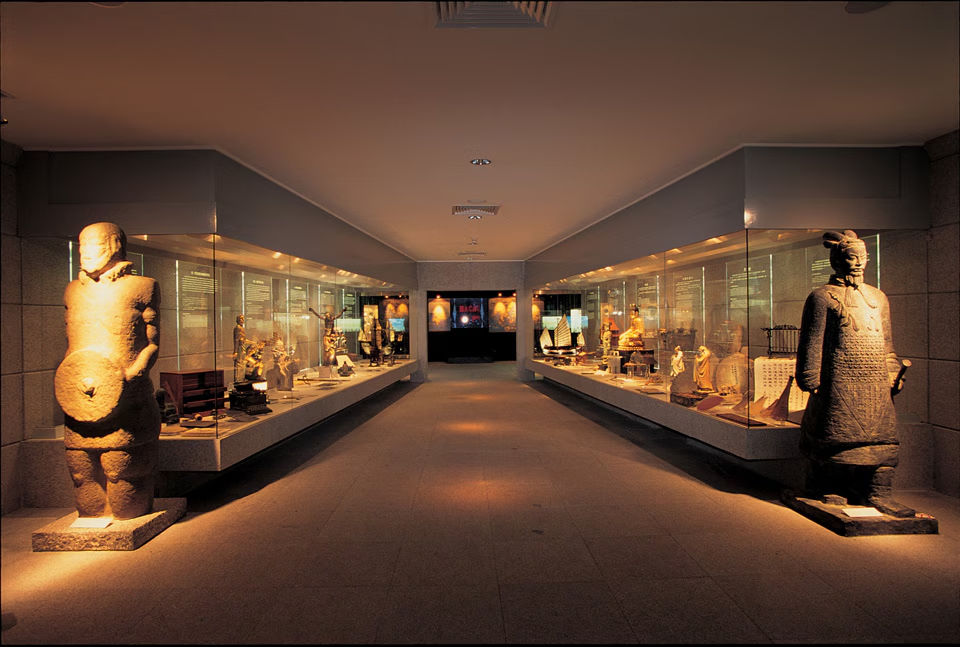




A Travel Guide to Macau
Macau, often dubbed the “Las Vegas of Asia,” is a vibrant Special Administrative Region of China that seamlessly blends Chinese and Portuguese heritage with modern glamour. Located just an hour’s ferry ride from Hong Kong, this compact destination is famous for its dazzling casinos, UNESCO World Heritage sites, and mouthwatering cuisine. Whether you’re a history buff, a foodie, or a thrill-seeker, Macau offers a unique cultural tapestry and endless entertainment. This guide will help you plan an unforgettable trip to this dynamic city.
Why Visit Macau?
Macau is a fascinating fusion of East and West, shaped by over 400 years of Portuguese colonial rule. Its historic center, a UNESCO World Heritage Site, boasts colonial architecture, ancient temples, and cobblestone streets. Beyond its cultural riches, Macau is a global gaming hub with opulent casino resorts rivaling those in Las Vegas. The city’s culinary scene, blending Cantonese, Portuguese, and Macanese flavors, is a delight for food lovers. Compact and walkable, Macau is perfect for a weekend getaway or a longer exploration, offering something for every traveler.
How to Get There
Macau is easily accessible by air, sea, and land, with excellent connections to mainland China and Hong Kong.
By Air: Macau International Airport (MFM) serves flights from major Asian cities like Bangkok, Singapore, Seoul, and Shanghai. Budget carriers like AirAsia offer affordable options. From the airport, free shuttle buses provided by major hotels (e.g., Venetian, Galaxy) take you to the city center in 10–15 minutes. Taxis cost around MOP 50–80.
By Ferry from Hong Kong: The most popular route is the high-speed ferry from Hong Kong (Sheung Wan or Kowloon) to Macau’s Outer Harbour Ferry Terminal or Taipa Ferry Terminal. Ferries run 24/7, take about 60 minutes, and cost HKD 160–200 one way. Book tickets via TurboJET or Cotai Water Jet websites, especially during weekends or holidays.
By Land from Mainland China: The Hong Kong-Zhuhai-Macau Bridge connects Macau to Hong Kong and Zhuhai via shuttle buses (MOP 65–70, 40 minutes). Buses depart from border checkpoints like Portas do Cerco (to Zhuhai) or the bridge’s Macau Port. High-speed trains from Guangzhou or Shenzhen to Zhuhai’s station connect to Macau via a short bus or taxi ride.
Getting Around Macau: Free Shuttles: Major casinos (Venetian, Wynn, MGM) offer free shuttle buses between ferry terminals, hotels, and key attractions. Public Buses: Affordable (MOP 6 per ride) and cover most areas, though signs are mainly in Chinese and Portuguese. Taxis/Ride-Hailing: Taxis are plentiful (starting at MOP 19), but drivers may not speak English. Use the Macau Taxi app for convenience. Walking: The historic center and Taipa Village are compact and best explored on foot.
Best Time to Visit
Autumn (October–December): Mild temperatures (20–25°C) and low humidity make this the ideal time for sightseeing and outdoor activities. Spring (March–May): Pleasant weather, though occasional rain. The Macau International Fireworks Display Contest (September–October, sometimes extending into early autumn) is a highlight.
Avoid: Summer (June–August) is hot and humid (up to 35°C) with frequent typhoons. Winter (January–February) is cool (10–15°C) but comfortable for indoor attractions. Tip: Avoid Chinese New Year (late January or February) and National Day (early October) for fewer crowds and lower hotel rates.
Must-Visit Attractions
Ruins of St. Paul’s (大三巴牌坊)
The Ruins of St. Paul’s (Sam Ba Sing Tzik) is one of Macau’s most iconic landmarks, a UNESCO World Heritage Site, and a symbol of the city’s unique blend of Portuguese and Chinese cultures. Located in the heart of Macau’s historic center, this 17th-century facade is all that remains of the Church of St. Paul, destroyed by fire in 1835. Surrounded by charming cobblestone streets, vibrant markets, and cultural attractions, the ruins are a must-visit for history buffs, photographers, and travelers exploring Macau’s rich heritage.





Senado Square (议事亭前地)
Senado Square is the cultural and historical heart of Macau, part of the Historic Centre of Macau inscribed on UNESCO’s World Heritage List in 2005. Its black-and-white wave-patterned tiles, designed by Portuguese artisans in the 1990s, reflect Macau’s maritime heritage, while the surrounding pastel-colored buildings—like the Leal Senado and St. Dominic’s Church—showcase colonial architecture. The square buzzes with activity, hosting festivals, lion dances, and firework displays during events like Chinese New Year and Christmas.



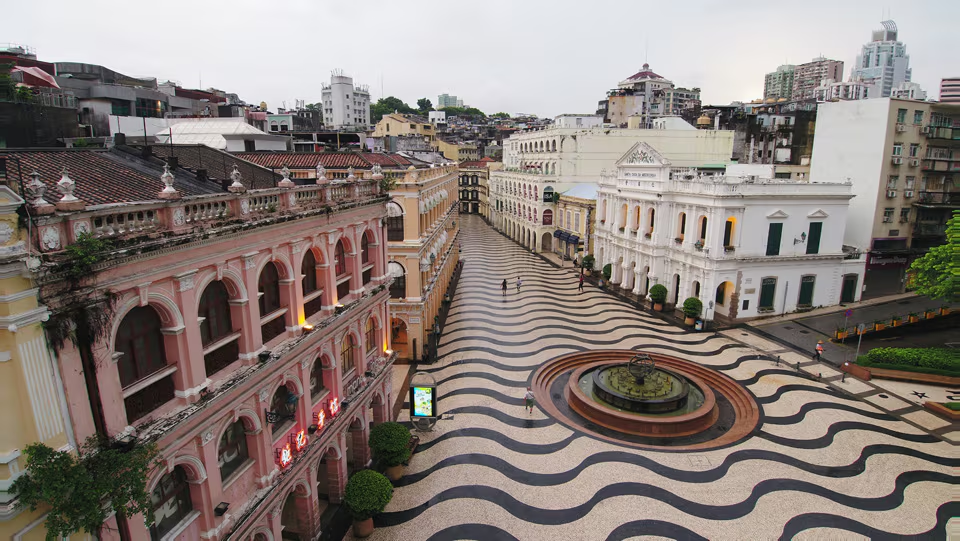
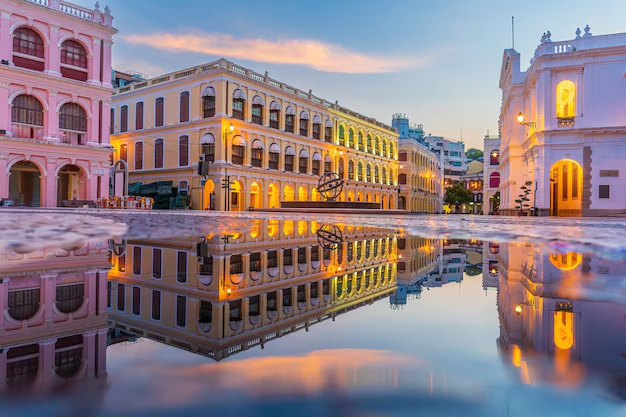
Macau Fisherman’s Wharf (澳门渔人码头)
Macau Fisherman’s Wharf, located on the waterfront of Macau’s Outer Harbour, is the city’s first theme park and a vibrant entertainment complex that blends Eastern and Western architectural styles. Spanning over 133,000 square meters, this landmark attraction offers a unique mix of dining, shopping, entertainment, and cultural experiences, making it a must-visit for travelers seeking a lively yet relaxed escape in Macau. Inspired by iconic waterfronts like San Francisco’s Fisherman’s Wharf, it combines replicas of global landmarks with Macau’s distinctive East-meets-West charm.





Macau Tower (澳门旅游塔)
Standing at 338 meters (1,109 feet), Macau Tower is the tallest structure in Macau and a defining landmark of this vibrant Special Administrative Region of China. Known as the Macau Tower Convention & Entertainment Centre, it offers breathtaking panoramic views, thrilling adventure activities, diverse dining options, and shopping, making it a must-visit for travelers seeking both excitement and relaxation.




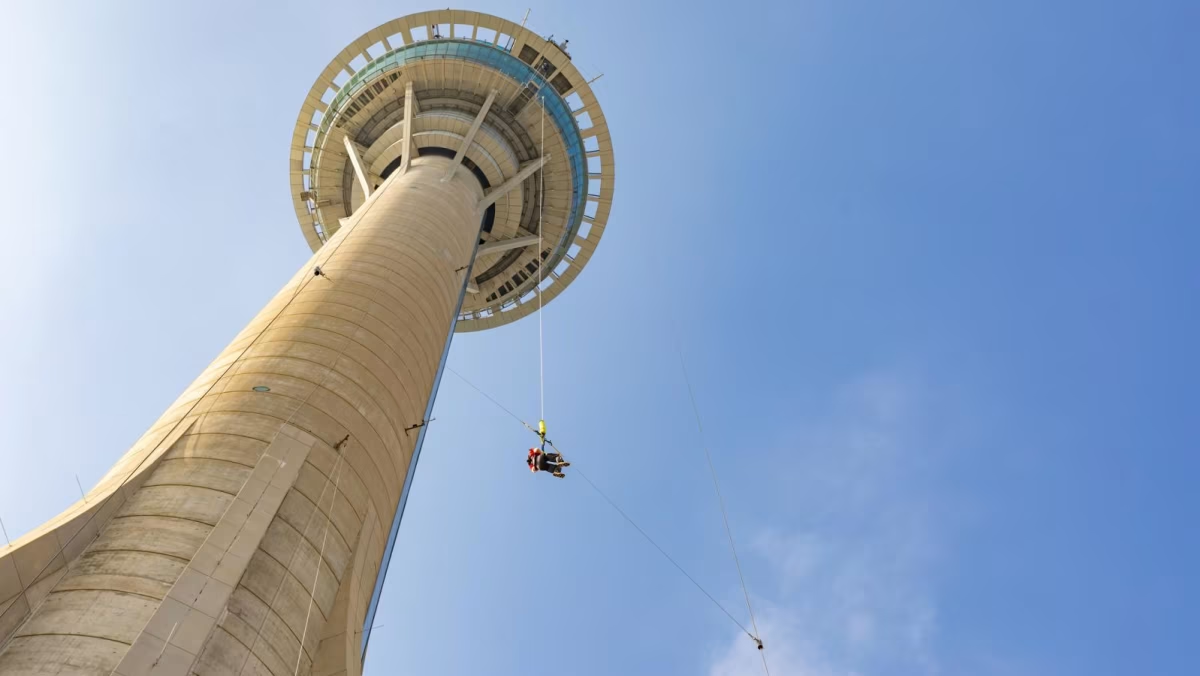
The Cotai Strip (路氹城金光大道)
The Cotai Strip in Macau, China, is a dazzling entertainment hub often dubbed the “Las Vegas of the East.” Built on reclaimed land connecting the islands of Taipa and Coloane, this vibrant stretch along Estrada do Istmo is home to some of the world’s largest casinos, luxury hotels, high-end shopping, and world-class dining. Whether you’re drawn to the thrill of gambling, the allure of extravagant shows, or the charm of themed resorts, the Cotai Strip offers a unique blend of East-meets-West glamour.





Taipa Food Street (氹仔美食街)
Taipa Food Street isn’t just a place to eat—it’s a journey through Macau’s soul. As a seasoned traveler, I appreciate its unpretentious charm and the way it balances tradition with accessibility. Whether you’re a foodie chasing flavors or a curious explorer seeking authenticity, Rua do Cunha delivers. So, lace up your walking shoes, bring your appetite, and dive into this delicious slice of Macau.





Where to Eat
Macau’s cuisine is a highlight, blending Chinese, Portuguese, and Macanese flavors.
Must-Try Dishes: Portuguese Egg Tarts: Best at Lord Stow’s Bakery (Taipa) or Margaret’s Café e Nata (Macau Peninsula). Minchi: A Macanese dish of minced meat with fried egg and potatoes, try at A Petisqueira in Taipa. African Chicken: A spicy Macanese specialty, served at Restaurante Litoral (MOP 150–200). Pork Chop Bun: A street food classic, available at Tai Lei Loi Kei in Taipa (MOP 30–50).
Dining Options: Street Food: Explore Rua do Cunha in Taipa for affordable snacks like fish balls and almond cookies. Mid-Range: António (Taipa) and Riquexo Café (Macau Peninsula) offer authentic Macanese and Portuguese meals (MOP 100–200 per person). Fine Dining: Robuchon au Dôme at The Dome (Grand Lisboa) serves Michelin-starred French cuisine (MOP 800+ per person).
Tip: Many casinos have food courts with affordable options (MOP 50–100) and international chains like Starbucks.
Where to Stay
Macau offers accommodations for every budget, from luxury resorts to boutique hotels.
Luxury: The Venetian Macao (Cotai): Spacious suites and access to the casino and shops, from MOP 1,200/night. Wynn Palace (Cotai): Opulent design with lake views, from MOP 1,500/night.
Mid-Range: Hotel Royal Macau (Macau Peninsula): Central location near Guia Fortress, from MOP 600–800/night. Grand Coloane Resort (Coloane): Quiet beachside option, from MOP 700/night.
Budget: Holiday Inn Express Taipa (Cotai): Modern and affordable, from MOP 400–600/night. Hostels: 5footway.inn Project Ponte 16 (Macau Peninsula) offers dorms from MOP 150/night.
Booking Tip: Book via Agoda, Booking.com, or hotel websites for deals. Weekdays are cheaper than weekends.
Tips for a Great Visit
Currency: Macau uses the Macanese Pataca (MOP), but Hong Kong Dollars (HKD) are widely accepted at a 1:1 ratio. Carry small bills for street vendors. Language: Cantonese and Portuguese are official languages, but English is common in hotels and tourist areas. Learn basic phrases like “Obrigado” (thank you in Portuguese).
Dress Code: Dress smartly for casinos (no flip-flops). Comfortable shoes are a must for walking the historic center. Safety: Macau is very safe, but beware of pickpockets in crowded areas like Senado Square.
Visa: Most nationalities (e.g., US, EU, Australia) get visa-free entry for 30–90 days. Check requirements before travel. Combine Your Trip: Pair Macau with a Hong Kong visit (1-hour ferry) or a day trip to Zhuhai via the Hong Kong-Zhuhai-Macau Bridge.
Final Thoughts
Macau is a captivating destination that packs a punch in its small size. From the grandeur of its casinos to the charm of its historic streets, it offers a unique blend of cultures, flavors, and experiences. Wander through colonial landmarks, savor Macanese delicacies, and try your luck at the gaming tables—all in a single trip. Plan ahead for peak seasons, embrace the city’s diversity, and let Macau’s magic leave you enchanted.
Happy travels!






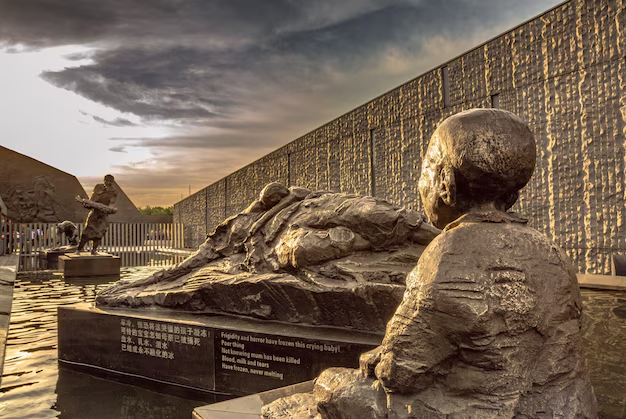







Leave a Reply